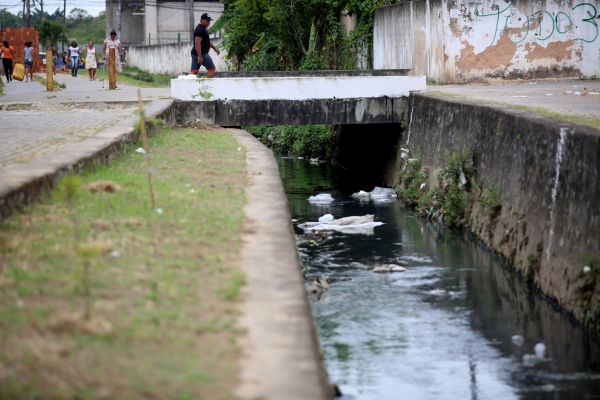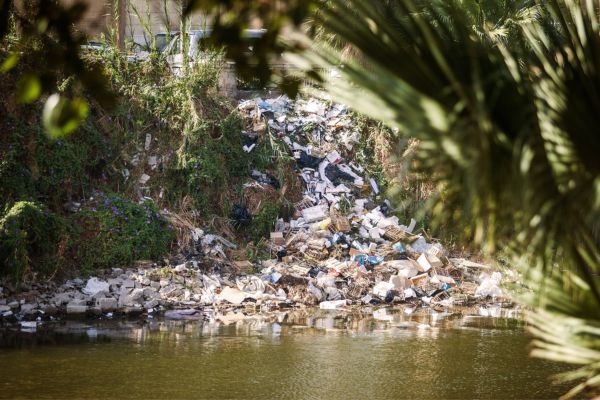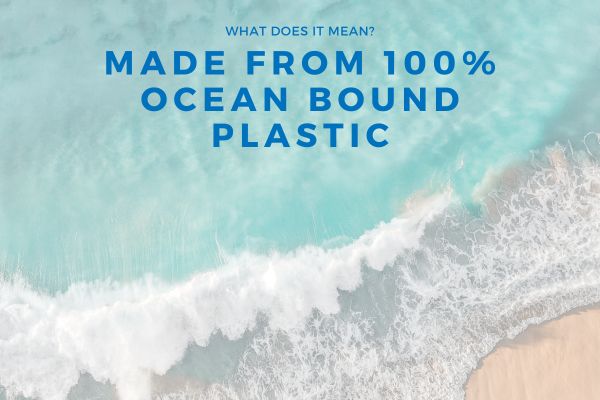You may have come across the term ocean bound plastic (referred to as OBP), particularly in reference to recycled material claims. But what does “Ocean Bound Plastic” mean, and is it a good thing?
When you see a product labeled as containing ocean bound plastic, it’s meant to convey that the plastic used in the product has been sourced from areas near coastlines, rivers, or other locations where plastic is at risk of entering the ocean. By incorporating this type of plastic into products, companies aim to help to replace virgin plastic while reducing plastic pollution and supporting efforts to clean up waterways.
But the term has become a topic of both environmental concern and, in some instances, controversy. Environmental campaigners have even filed a complaint with the Australian Competition and Consumer Commission (ACCC). The organizations claim that products labeled as “ocean bound plastic” may not be as sustainable as they seem, therefore misleading consumers or greenwashing. The ACCC is presently looking into these accusations.
Ambiguity in the term ocean bound lies in the fact that it is often used inconsistently and lacks a universally accepted definition. While some use it to describe plastic on a direct path to the ocean, others employ it more broadly to include plastic in proximity to water bodies, regardless of its actual trajectory. In other words, it may refer to plastic collected for recycling that would not have ended up in the ocean but just happens to be collected near a waterbody or the ocean.
This variation in interpretation can lead to confusion and miscommunication, making it challenging to assess the true extent of the plastic pollution problem. This lack of a standardized definition and misuse of the term highlights the need for clearer terminology and increased transparency.
This article delves into the definition and use of ocean bound plastic and the potential issues resulting from the use of the term.
Defining Ocean Bound Plastic
Ocean-bound plastic is plastic waste that is at risk of entering the ocean due to improper disposal, inadequate waste management, or accidental release. Unlike ocean plastic that is already drifting in open waters, ocean-bound plastic is in close proximity to coastlines, rivers, and other water bodies, making it highly susceptible to reaching the sea. Once in the ocean, these materials can have devastating consequences for marine life and ecosystems.
In response to the increased use of recycled plastic in products, brands initially embraced the term “ocean plastic” to raise awareness about the environmental impact of plastic pollution in oceans and to showcase their commitment to sustainability.
However, scrutiny revealed that the term was not always substantiated by the use of plastic actually recovered from the ocean. This led to a shift towards the term “ocean-bound plastic,” driven largely by the need for brands to maintain integrity and provide more accurate information to consumers. But the change also signifies a proactive approach to addressing plastic pollution, highlighting prevention and interception measures before plastic reaches marine ecosystems..
Sources of Ocean Bound Plastic
Ocean bound plastic reaches the ocean through several different channels:
- Improper Waste Disposal: A significant contributor to ocean bound plastic is the improper disposal of plastic waste by individuals, industries, and communities. Unfortunately, this still occurs in many parts of the world due to inadequate waste management systems and a lack of recycling infrastructure.
- Stormwater Runoff: Rainfall and stormwater runoff can transport plastic debris from streets, beaches, and other environments directly into rivers and coastal waters. This runoff acts as a conveyor belt for plastic waste, facilitating its journey from urban areas to the ocean.

- Inadequate Landfill Management: Improperly managed landfills can release plastic waste into nearby water bodies through leachate, which is liquid that percolates through the waste and can carry pollutants, including plastics, into rivers and oceans.

- Abandoned Fishing Gear: Discarded or lost fishing gear, often made of durable and long-lasting plastics, poses a significant threat to marine life. These “ghost nets” continue to entangle marine animals, leading to injuries and fatalities.
Why is it Important We Stop Plastic Flowing Into The Ocean
Plastic in the ocean is a problem regardless of its source. It threatens marine life, ecosystems, and, ultimately, our own well-being. The excess of plastic reaching the ocean has become a pressing environmental issue, representing a crisis of global proportions.
Some of the many impacts on marine life and ecosystems include:
- Entanglement: Plastic poses a direct threat to marine life through entanglement. Animals such as seals, turtles, and seabirds can become ensnared in discarded fishing nets or other plastic debris, leading to injuries or death. And it’s not just marine animals that can get caught up in our waste plastic. Land animals can also get tangled or have limbs or their head caught in plastic waste.
- Ingestion: Perhaps the most insidious impact of plastic is its ingestion by marine species. Fish, seabirds, and marine mammals often mistake plastic for food, leading to ingestion and subsequent health issues. Plastics can accumulate in the digestive tracts of these animals, causing malnutrition, internal injuries, and sometimes death.
- Microplastics: Plastics do not degrade but instead break down into smaller and smaller pieces called microplastics. These small pieces of plastic have found their way into every corner of our environment, including human tissue. Research is ongoing to understand the true consequences of these particles, including their ability to carry harmful microorganisms.
- Habitat Destruction: The accumulation of plastic debris in coastal and marine environments can lead to habitat degradation. Coral reefs, seagrass beds, and other critical ecosystems can be smothered by plastic, disrupting the delicate balance of these environments and affecting the species that depend on them.
- Chemical Contamination: Plastics can absorb and concentrate harmful pollutants from the surrounding environment. When ingested by marine organisms, these chemicals can enter the food chain, potentially reaching humans who consume seafood.
The magnitude of the ocean plastic crisis is staggering. According to estimates by the World Economic Forum, without significant intervention, the weight of accumulated plastic in the world’s oceans could surpass the weight of all the fish by 2050. This grim projection underscores the urgent need for comprehensive and effective strategies to address the issue.
Potential issues with using the term Ocean Bound Plastic
Manufacturers making new products from recycled plastic is surely a good thing, right? Well, yes, it is, but we want to make sure that what they are telling us is true. Greenwashing concerns primarily revolve around the potential of misleading or exaggerating the claims made by brands to appear more environmentally friendly than they actually are.
Some of the specific greenwashing concerns with using the term OBP are:
- Lack of Clear Definitions: There are no standardized definitions or industry-wide norms on how to define the word consistently, leaving it up to brands to decide. This can lead to consumer confusion and distrust, particularly if brands use the term differently.
- Incomplete Information: Greenwashing may result when brands provide incomplete or selective information about their use of ocean bound plastic. Without a complete understanding of the entire production process, consumers may be misled into thinking a product is more sustainable than it actually is.
- Limited Contribution to Plastic Reduction: Some companies might use only a small amount of ocean bound plastic in their products while exaggerating this aspect to create a positive image. While any effort to reduce plastic pollution is valuable, the overall impact may be limited if there is just a small percentage.
- Ignoring Broader Environmental Issues: Greenwashing concerns arise when companies focus solely on the use of ocean bound plastic without addressing other environmental issues related to their production processes, such as energy consumption, carbon emissions, or the overall life cycle of the product.
- Overlooking Social and Ethical Aspects: Greenwashing can also occur if companies emphasize the environmental benefits but overlook social and ethical considerations, such as fair labor practices, community engagement, and the impact on local ecosystems during the plastic collection process.
How to Check Brand Claims
To address these greenwashing concerns, it’s important for companies to adopt transparency and adhere to clear standards in their use of the term. They should work to incorporate verifiable certifications where possible and demonstrate a comprehensive commitment to environmental stewardship beyond the use of ocean bound plastic.
Consumers should be vigilant, seeking products from companies with verified sustainable practices to ensure that theIR claims about ocean bound plastic are authentic and contribute meaningfully to addressing environmental challenges.
Some things to look out for include:
- Look for certifications: Brands should be transparent by providing verified certification. Examples include OceanCycle Certification or the OceanWorks Guarantee.
- Check the details: Transparency is an important way to combat greenwashing, so look for brands that provide detailed information about their sourcing, collection methods, and overall sustainability strategy.
- Talk the talk: We want to see brands that show efforts in addressing the root cause of plastic pollution by implementing strategies to reduce overall plastic consumption and improve recycling systems. This can involve designing out unnecessary plastics from their products, replacing plastic with more environmentally friendly materials, and creating or supporting the availability of recycling systems. A great example of this is when brands offer a take back program for their products like the Arvin Goods take back bag.
- They should be Ethical: Ensure brands follow fair labor practices and community engagement in these initiatives. This information should be readily available on their website.
- No Exaggeration: Avoid exaggerated or misleading claims and look for brands that offer clear and accurate communication.
In summary, the term “ocean bound plastic” is meant to convey a positive environmental message by addressing the issue of plastic pollution. We applaud efforts to reduce plastic pollution in and around the ocean, and we encourage the use of recycled plastic in new goods. However, to be effective and gain consumer trust, companies must provide transparent information about their sourcing and production processes while also addressing broader sustainability goals.
The FAQs
What is 100% ocean bound plastic?
“100% ocean bound plastic” signifies a product or material entirely sourced from plastic waste collected near water bodies, preventing it from reaching the ocean. By using this material, companies can create a positive impact by reducing marine pollution and promoting responsible consumption practices.
Is ocean bound plastic good or bad?
Assessing ocean bound plastic as good or bad depends on various factors. On the positive side, its use in products contributes to environmental conservation by preventing plastic waste from entering marine ecosystems. It supports cleanup efforts, raises awareness about plastic pollution, and encourages sustainable practices. However, concerns arise around transparency, verification, and the potential for greenwashing. Some critics argue that relying solely on collecting and repurposing ocean bound plastic may not address the root causes of plastic pollution and could divert attention from reducing overall plastic production and consumption. Ultimately, its effectiveness hinges on responsible sourcing, ethical collection methods, and a holistic commitment to long-term environmental sustainability.
How is ocean bound plastic different from regular recycled plastic?
These two types of plastic differ primarily in their sourcing and collection processes. Ocean bound plastic is specifically collected from areas near coastlines, rivers, and other locations at risk of entering the ocean, intercepting it before it reaches marine environments. In contrast, regular recycled plastic encompasses a broader range of post-consumer or post-industrial plastic waste collected through recycling programs.
While both contribute to environmental sustainability, ocean bound plastic places a stronger emphasis on proactive measures to prevent marine pollution, making it a more targeted solution to address the specific challenges associated with plastic entering the oceans.
Is ocean bound plastic recyclable?
Yes, ocean bound plastic is generally recyclable. The key distinction lies in the sourcing and collection process rather than the material’s recyclability. It’s collected from areas near water bodies before it enters the ocean, and once retrieved, it can undergo the same recycling processes as other types of plastic; however, it must still meet recycling standards.
The recyclability of products made from this recycled material depends on a few factors. Its recyclability depends on the type of plastic it is made from, whether it is HDPE or PET, for example, and the end product it’s made into. Just like any plastic product, it’s affected by limitations in collection services, processing options, and markets for recycled material.
Is ocean bound plastic greenwashing?
Greenwashing is a deceptive marketing practice where a company exaggerates or falsely claims environmentally friendly practices to create a misleading perception of its commitment to sustainability.
The use of ocean bound plastic in products is not by itself greenwashing, but it has the potential to be used that way. Concerns particularly arise when companies use this term without providing transparent information on the sourcing, collection methods, and overall sustainability practices of the recycled plastic.














